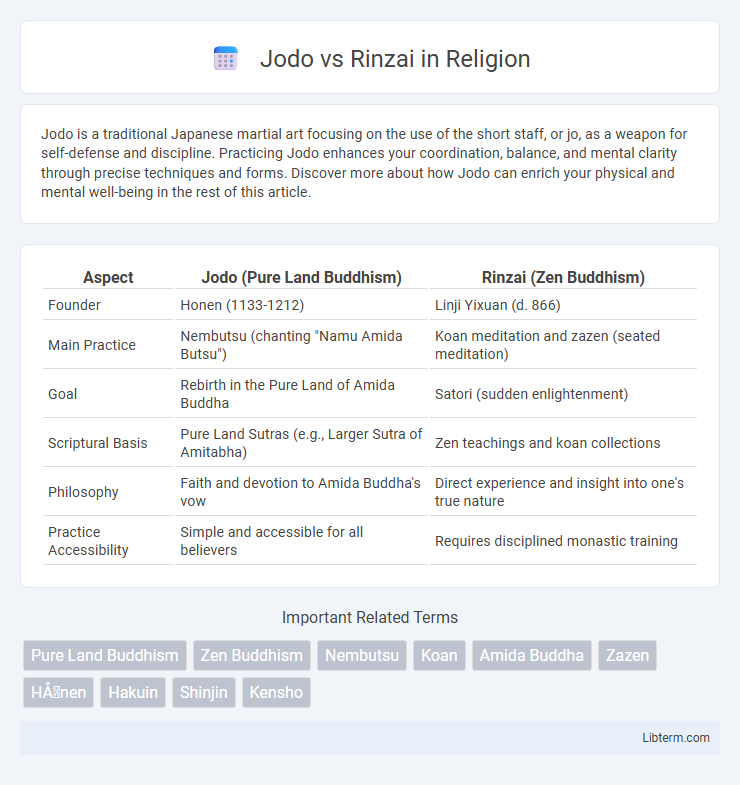Jodo is a traditional Japanese martial art focusing on the use of the short staff, or jo, as a weapon for self-defense and discipline. Practicing Jodo enhances your coordination, balance, and mental clarity through precise techniques and forms. Discover more about how Jodo can enrich your physical and mental well-being in the rest of this article.
Table of Comparison
| Aspect | Jodo (Pure Land Buddhism) | Rinzai (Zen Buddhism) |
|---|---|---|
| Founder | Honen (1133-1212) | Linji Yixuan (d. 866) |
| Main Practice | Nembutsu (chanting "Namu Amida Butsu") | Koan meditation and zazen (seated meditation) |
| Goal | Rebirth in the Pure Land of Amida Buddha | Satori (sudden enlightenment) |
| Scriptural Basis | Pure Land Sutras (e.g., Larger Sutra of Amitabha) | Zen teachings and koan collections |
| Philosophy | Faith and devotion to Amida Buddha's vow | Direct experience and insight into one's true nature |
| Practice Accessibility | Simple and accessible for all believers | Requires disciplined monastic training |
Introduction to Jodo and Rinzai Traditions
Jodo and Rinzai represent two principal schools of Japanese Buddhism, distinguished by their unique spiritual practices and philosophical emphasis. Jodo, or Pure Land Buddhism, centers on devotional recitation of the Nembutsu, invoking Amitabha Buddha to achieve rebirth in the Pure Land, promoting faith and surrender as paths to enlightenment. Rinzai Zen emphasizes koan practice and rigorous meditation (zazen), focusing on sudden awakening (satori) and direct insight into one's true nature through disciplined, experiential inquiry.
Historical Origins and Development
Jodo Buddhism, founded by Honen in 12th-century Japan, emphasizes faith in Amida Buddha's Pure Land for salvation and developed as a response to the perceived difficulty of traditional Buddhist practices. Rinzai Zen, introduced by Eisai in the 12th century, centers on sudden enlightenment through koan meditation and rigorous discipline, rooted in Chinese Chan Buddhism. Both traditions significantly shaped Japanese religious history by offering distinct paths to spiritual awakening during the Kamakura period.
Core Beliefs and Philosophical Differences
Jodo Buddhism centers on faith in Amida Buddha and reliance on the chanting of the Nembutsu for enlightenment and rebirth in the Pure Land, emphasizing grace and devotion over self-powered practice. Rinzai Zen focuses on direct experience through rigorous meditation (zazen), koan study, and sudden enlightenment (satori), stressing personal effort and insight to transcend dualistic thinking. These core differences reflect Jodo's reliance on other-power (tariki) versus Rinzai's emphasis on self-power (jiriki) and immediate experiential awakening.
Key Practices and Rituals
Jodo Buddhism emphasizes devotional practices centered on the chanting of the nembutsu, "Namu Amida Butsu," to invoke the power of Amitabha Buddha for rebirth in the Pure Land, with daily rituals often performed at home or in temples. Rinzai Zen prioritizes rigorous meditation (zazen), koan study, and direct teacher-student interaction to achieve sudden enlightenment (satori), incorporating formal monastic rituals such as chanting sutras and bowing during sesshin intensive retreats. Both traditions maintain deep respect for ritual but diverge in practice focus: Jodo on faith and recitation, and Rinzai on meditation and experiential insight.
Approaches to Enlightenment
Jodo Buddhism emphasizes faith and devotion to Amida Buddha as the primary path to enlightenment, relying on the practice of the nembutsu (recitation of Amida's name) to attain rebirth in the Pure Land. Rinzai Zen Buddhism centers on sudden enlightenment through rigorous meditation (zazen) and the use of koans--paradoxical questions or statements designed to transcend rational thought and trigger satori. The Jodo approach prioritizes grace and faith for salvation, while Rinzai stresses direct personal experience and disciplined practice for awakening.
Major Figures and Teachers
Jodo Buddhism, founded by Honen, emphasizes devotion to Amida Buddha through the practice of nembutsu, with key figures including Shinran, who further developed Pure Land teachings. Rinzai Zen, established by Eisai, prioritizes koan study and sudden enlightenment, with notable teachers such as Hakuin Ekaku revitalizing its rigorous meditation methods. Both traditions significantly shaped Japanese Buddhism through distinct approaches to spiritual practice and pedagogy.
Role of Meditation in Jodo vs Rinzai
Jodo Buddhism emphasizes nembutsu meditation, a focused recitation of Amitabha Buddha's name to achieve rebirth in the Pure Land, relying on faith and devotional practice. Rinzai Zen centers on zazen, or seated meditation, fostering sudden enlightenment through intense mindfulness and koan contemplation to transcend ordinary perception. The contrasting meditation approaches highlight Jodo's devotional reliance versus Rinzai's rigorous, experiential path to awakening.
Influence on Japanese Culture and Society
Jodo Buddhism, emphasizing Pure Land teachings and devotional practices, deeply influenced Japanese culture by inspiring artistic expressions like Amida Buddha statues and calligraphy, fostering a pervasive sense of faith and hope among common people. Rinzai Zen, centered on rigorous meditation and koan practice, shaped samurai ethics and the aesthetics of traditional arts such as tea ceremony, ink painting, and martial arts, promoting discipline and mindfulness. Both schools significantly impacted Japanese societal values, with Jodo fostering popular religious engagement while Rinzai nurtured elite spiritual cultivation and cultural refinement.
Contemporary Relevance and Global Spread
Jodo Buddhism emphasizes pure faith in Amida Buddha and has gained global traction through its accessible approach to salvation, attracting diverse contemporary practitioners seeking spiritual comfort. Rinzai Zen, with its rigorous koan practice and meditation-centered discipline, appeals to modern audiences interested in mindfulness, mental clarity, and direct experiential insight. Both traditions contribute uniquely to the global Buddhist landscape, with Jodo promoting devotional practice and Rinzai fostering meditative depth across Western and Asian communities.
Conclusion: Choosing Between Jodo and Rinzai
Choosing between Jodo and Rinzai depends on one's spiritual goals and preferred practice style; Jodo emphasizes devotional chanting of the Nembutsu to attain rebirth in the Pure Land, appealing to those seeking faith-based salvation. Rinzai centers on rigorous Zen meditation and koan study, offering a direct path to enlightenment through disciplined self-realization. Both traditions provide profound insights, with Jodo favoring grace and devotion, while Rinzai demands active introspection and mental discipline.
Jodo Infographic

 libterm.com
libterm.com